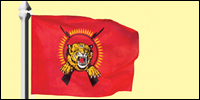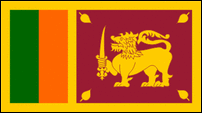Lion flag controversy comes to forefront after NPC Minister declining to hoist it in Vavuniyaa
“Without giving adequate recognition to the original inhabitants of this Island and their religion our National flag gives undue importance to the Sinhalese and to Buddhism. This is the reason for the resentment of the Hon’ Education Minister,” responded Justice C.V. Wigneswaran, the chief minister of Northern Provincial Council (NPC) in his weekly media address formed as Q&A. NPC CM's response came as SL Ministers in South started to react to media reports on the episode. On Wednesday, SL Governor to North, Reginald Cooray also exposed himself by interpreting the democratic and peaceful protest by the NPC Minister as “violating the constitution of the Democratic Socialist Republic of Sri Lanka”. The SL Governor and ultra-nationalist Sinhalese in South seem to have not learnt their lessons from the recent history, commented political observers in Jaffna.
SL Governor Reginald Cooray was writing to NPC Chief Minister Justice Wigneswaran even after the CM has gone on record explaining his view on the issue.
“This is an occasion, God sent, for our Sinhalese brethren to understand the hidden negative feelings among us Tamils embedded in our hearts for so long,” Justice C.V. Wigneswaran said in his weekly media release addressed in a question-and-answer form, three days before the letter from Mr Cooray.
The Tamil protest to the Lion Flag is not a recent one after seeing it as a flag of genocide in 2009.
More than 60 years ago, finding the flag as a “gratuitous insult” to the Tamil-speaking people, the Tamil mainstream polity in the island had openly rejected it.
The flag symbolically discriminates Tamils and Muslims as ‘outsiders’ as opposed to the sword-wielding Sinhalese Lion.
The following is the relevant resolution passed by the most popular Tamil political party at that time, Ilankai Tamil Arasuk Katchi (ITAK) or the Federal Party, in its First National Convention convened at Trincomalee in 1951:
Resolution No. 6 passed at the First National Convention of the Ilankai Tamil Arasuk Katchi held on the 13th, 14th and 15th of April 1951 at Trincomalee
The convention rejects the official flag of Ceylon as an insult to the Tamil-speaking people.The First National Convention of the ITAK rejects the official flag of Ceylon as constituting a gratuitous insult to the Tamil speaking people in this Island, inasmuch as, they are assigned two narrow stripes which are placed as extraneous accretions outside the inner vertical border of the Sinhalese Lion Flag which is sacrosanctly preserved in its entirety as the all important part of the flag. This convention points out that this official flag of Ceylon correctly symbolises the present humiliating status of the Tamil speaking people in Ceylon, who are placed in the position of out castes in the body-politic.This convention reiterates its resolve to win freedom and redeem the self-respect of the Tamil-speaking people; and declares that the union flag of Federal Ceylon will be framed on non-communal principles and designed on the highest ideals of the present age.
After turning the symbolic contents of the flag into realties through a genocidal war, the Sri Lankan state, which is virtually a Sinhala State, is now using the flag and the Sinhala ‘national’ anthem as tools for psychological subjugation of even little school children.
After complicity with genocide, regional and global agenda-setters nowadays take an orchestrated interest in popularising the flag and phrases like ‘Sri Lankan Tamil’, ‘Sri Lankan diaspora’ etc.
The national flag of genocidal Sri Lanka features a golden lion brandishing a sword.
The flag is adopted from the Kandyan kingdom, one of the three kingdoms in the island before and during the times of European colonialism.
The Kingdom of Kotte was the first to succumb to Portugues influence, effectively surrendering its sovereignty in 1597. The Jaffna Kingdom was conquered by the Portuguese in 1621 and the Kandyan Kingdom by the British in 1815.
On 04th February 1948, when Ceylon gained ‘independence’ as a single ‘State’, it’s first Prime Minister D.S. Senanayake hoisted the Lion flag, which had been adopted from the Kandyan flag.
The sovereignty of Jaffna Kingdom, which passed to the colonial rulers through capture, was never reverted to the Tamil people in the post-colonial era. Tamil demand for federalism as it was popularly known as 50:50 was intentionally ignored by the British who were pre-occupied with introducing their Westminster model of ‘democracy’ in the island.
Eezham Tamils protested vehemently when Sinhala parties in South adopted the lion flag as the ‘national’ flag soon after the British relinquished their suzerainty over the island in 1948.
Opposition to the flag, since then, has been part of the Tamil movement.
The practice of hoisting the lion flag was secretly and openly shunned in most Tamil areas as the Tamil movement became militant in character in late 1970s.
The Lion flag was amended in early 50's with two stripes to represent Tamil and Muslim ‘minorities’.
In 1972, the finials that represented Buddhism were replaced with Bo leaves to indicate that ‘Sri Lanka’ is a Buddhist country as the government of the time changed the country’s name from Ceylon and introduced a majoritarian constitution, dumping the safeguards for the island’s ‘minorities’ in the Ceylonese constitution, that had been introduced by the British.
The transitions and constitutions were implemented without the democratic mandate of Eezham Tamils and amidst open boycott by Tamils in the North and East.
The Lion Flag of the Sri Lankan state is seen as a symbol of oppression by the Eezham Tamils.

They rejected it long back for the explicit communal symbolism in it, pointing out that the lion in the flag, taken as a symbol of the Sinhala people according to their myths, holding a sword against 'minorities' represented by the colour stripes in the flag, was a deliberately designed insult to Tamils and Muslims.
Eezham Tamils eventually came up with their own Tamil Eelam national flag with a Tiger emblem when Tamil militancy evolved into a full-fledged independence struggle with its own de-facto state administration in the 1990s.
The Tiger emblem has its origins from the ancient Chola Dynasty from Tamil Nadu.
The eponymous progenitor of the Sinhala people, according to their mythological history, is a lion.
Sinhala Buddhists believe that their nation is descended from a union between a North Indian princess and a lion that had carried her away to his lair in the forest.
The princess had a son and a daughter by the lion. The son was called Sinhabahu and the daughter Sinhasivali.
Sinhabahu killed his father, the lion, when he grew up. Then he married his sister Sinhasivali and begat a son called Vijaya.
According to Sinhala Buddhist legends upheld by modern Sinhala historians, Viajaya was banished by his father from his kingdom for being a miscreant.
He and his accomplices came to the island, married Tamil princesses from the South Indian Pandya Kingdom and founded the ‘Sinhala race’, according to the mythology of Sinhala Buddhists.
Related Articles:
03.02.98 Assaults over Lion flags
23.12.97 5000 Lion flags sent to Jaffna
23.11.97 SLA orders Tamil homage to lion flag


கருத்துகள் இல்லை:
கருத்துரையிடுக